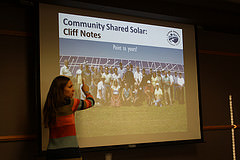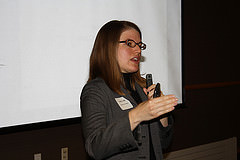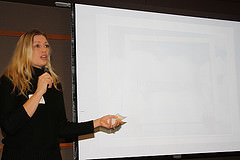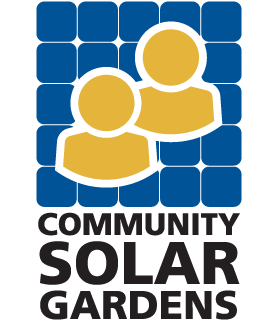Community solar has been THE hot energy issue in Minnesota so far this year. In 2013 the Minnesota Legislature passed legislation that required Xcel Energy, Minnesota’s largest investor owned utility, to administer a community solar gardens (CSG) program, and enabled other utilities to administer them as well. Community Solar Gardens are centrally-located solar photovoltaic (PV) systems that provide electricity to participating subscribers.
Xcel Energy’s Solar*Rewards Community program officially opened on December 12th, 2014. Minnesota currently has 14 megawatts of solar, but with the mandate of 1.5% solar, Minnesota’s solar capacity will increase greatly: by 2020, Minnesota is expected to have 400 megawatts of solar capacity.
On December 17, 2014 the Minnesota GreenStep Cities program hosted a workshop for cities interested in community solar. The presenters covered the basics of community solar gardens, the different project models, what roles cities can play, land and roof leasing best practices, and available resources. A lot of the presentations were focused on Xcel Energy customers, but the key information and resources were applicable to other utility territories as well.
The presenters were Lissa Pawlisch with the Clean Energy Resource Teams, Holly Lahd from the Minnesota Department of Commerce, Division of Energy Resources, and Laura Burrington with Minnesota Renewable Energy Society. They were joined on the panel by John Wold from Xcel Energy.
What are typical roles with community solar garden projects?
Lissa kicked off the workshop with a presentation on the basics of community solar and addressed what roles cities can play. Before starting, below are some key terms that are important to know to understand community solar. You can also click here for a document that lays out these terms and roles.
- Subscriber – The individual or entity that subscribes to a project. This person does not own a particular panel; rather, they subscribe to the energy benefits that one or more panels produce.
- Developer – The group that actually develops the project to get it going.
- Operator – The group that manages subscriptions and the CSG over time (often the developer and operator are one in the same).
- Installer – Those who install the system.
- Finance Partner – Provides financing for the project.
- Host Site – Where the solar garden is located. It could be either a ground or roof mount system.
- Utility – The organization that manages the local electric grid and takes in the electricity the CSG produces. The utility also pays out the credit to their electric members who own the community solar subscription.
- Site Assessor – The person who makes sure the host site is a good site.
- Outreach Partner – Those who help find subscribers.
What are the utility and payment models for community solar in Minnesota?
 Lissa Pawlish explained there are two models for community solar. One is the Cooperative Utility model, where the utility hosts and manages the CSG. They have a direct relationship with their members who would be the subscribers and the subscribers have no interaction with a third party.
Lissa Pawlish explained there are two models for community solar. One is the Cooperative Utility model, where the utility hosts and manages the CSG. They have a direct relationship with their members who would be the subscribers and the subscribers have no interaction with a third party.
The other model is the Xcel Energy program, which is more like a triangle. The subscriber pays the developer of the CSG for their subscription and the developer sells the CSG electricity to the utility who then credits the individual subscribers on their electric bills. The developers will collect payment from the subscribers in one of two ways: either (1) in a single upfront payment, or (2) as “pay as you go,” where subscribers make smaller monthly payments for their subscription. Xcel will then credit participating customers by using a specific rate. A chart with the rate breakdown can be found in the primary PowerPoint from the workshop. The rates will be updated every year. Currently, for a residential customer subscribing to a garden larger than 250 kilowatts the credit will be $0.14033 per kWh. This figure is under the enhanced rate structure, for subscribers who do not wish to own their RECs (renewable energy credits).
There are fees associated with the development of a CSG: in Xcel territory there is a $100 refundable deposit for an application; a one-time fee of $1,200 per garden is also assessed, a metering charge per month ($5.50 for single phase and $8.00 for three phase) as well as an annual fee of $300 to maintain subscriber updates. These fees will be paid directly by the developer and indirectly by subscribers through their subscription payments.
Community Solar Gardens can be a maximum of 1,000 kilowatts (1 megawatt) and must have at least five subscribers of which none subscribe to more than 40% of the garden’s total capacity. That means that for a 1 megawatt garden, no one subscriber could subscribe to more than 400 kilowatts. Subscribers can subscribe to more than one CSG, but cannot subscribe to more than 120% of their average energy consumption. The 120% average is derived from the individuals’ historic energy usage: if they are new to their location, Xcel will figure out an average energy usage for the location based off of the average energy usage for other similar types of buildings. Subscribers’ average energy usage will only be checked when they subscribe, change their subscription, or change residence. It will not be checked on an annual basis. The details of being “out of compliance” of the 120% rule are still being worked out, but if there is a compliance check in which a subscriber is found to be out of compliance, they will likely not be credited for the power generated beyond 120% of their usage.
Community solar gardens are focused on individuals, so what roles can cities play?
 There are three major roles for cities: outreach, being a host site, and being a subscriber. The easiest role for cities is outreach. Cities can inform their constituents of the community solar program and of local gardens accepting subscriptions, though it’s important to not play favorites and remain neutral among available gardens. Cities can also inform their constituents by holding educational sessions on their own or in conjunction with a local environmental commission.
There are three major roles for cities: outreach, being a host site, and being a subscriber. The easiest role for cities is outreach. Cities can inform their constituents of the community solar program and of local gardens accepting subscriptions, though it’s important to not play favorites and remain neutral among available gardens. Cities can also inform their constituents by holding educational sessions on their own or in conjunction with a local environmental commission.
Another option is for cities to be the host site of a CSG, which they are typically well suited for since they often own large buildings, such as community centers and city halls. These buildings have wide roofs with little shading and will be around for 20 or more years, making them ideal locations for a solar installation.
The final option for cities is to be a subscriber to community solar. For that to happen there are a lot of questions that need to be flushed out, such as: Would a city as a whole be a subscriber or would individual departments be subscribers? How would their average energy use be determined? If any departments move, merge, or new city buildings are added or removed how would that be tracked to determine when a compliance check of the 120% rule is needed? There are no established answers to these questions yet. As of now, cities should work with their utility account manager and become familiar with their electric bill to work through these questions.
There are also examples for cities to look to in Colorado, which has its own community solar program with Xcel Energy that is not the same as Minnesota’s, but is similar. Cities in Minnesota could look to Colorado cities for their expertise and model RFPs. No matter what course a city takes, it’s important to be transparent. Being transparent about the process will help the city and its citizens know that a fair deal was reached and will also allow others to replicate the process.
What questions should communities be asking about leases for community solar?
 The Public Utility Commission (PUC) establishes the rules and rates for Minnesota’s community solar program. They also supervise the program. Their jurisdiction covers some, but not all of the different community solar relationships. They cover the utility-operator and utility-developer relationships, but mostly not the customer-developer relationship. Because of this, it is important for potential subscribers to do their homework and be aware of what they sign up for. CERTs and the Department of Commerce have released resources that can help consumers be prepared to work with developers (resources available on the bottom of this page). Another group that is establishing community solar best practices around roof and land leases is Minnesota Renewable Energy Society. Laura Burrington presented at the workshop on their work.
The Public Utility Commission (PUC) establishes the rules and rates for Minnesota’s community solar program. They also supervise the program. Their jurisdiction covers some, but not all of the different community solar relationships. They cover the utility-operator and utility-developer relationships, but mostly not the customer-developer relationship. Because of this, it is important for potential subscribers to do their homework and be aware of what they sign up for. CERTs and the Department of Commerce have released resources that can help consumers be prepared to work with developers (resources available on the bottom of this page). Another group that is establishing community solar best practices around roof and land leases is Minnesota Renewable Energy Society. Laura Burrington presented at the workshop on their work.
Minnesota Renewable Energy Society received Renewable Development Fund (RDF) funding to build two CSGs, a rural garden and an urban one. They are developing model land and roof lease agreements that are expected to be available early March. Until those model leases are available there are some questions and recommendations Laura posed for people to consider, listed below.
Questions about roof or land leasing:
- Length of CSG leases
- 25 years in Xcel territory
- 20-40 years in Coops territories
- What will your compensation be (usually about 3-5% of energy produced)?
- How often will the compensation be paid out?
- What is the maintenance clause for use and access?
- What insurance is there and who will cover what?
- What happens after the lease? Who removes the equipment and will the site be returned to the same condition?
Questions specifically for roof-mounted projects:
- Will the installation penetrate the roof?
- If it will penetrate will that violate any roof warranties?
- How much uninterrupted space does the roof have? (A 1MW installation needs about 150,000 sq. feet of uninterrupted roof.)
- Look into doing any roof replacements or repairs before a solar installation goes in.
Questions specifically for ground-mounted projects:
- How much space do you have? (ground-mounted systems need about 8 acres)
- Will a CSG comply with local zoning code?
- Will you be held responsible for preparing the site or restoring it after the project?
- Look into developing on unusable land, such as brownfields.
The community solar market is new to Minnesota, so there are still a lot of questions and unknowns. In order for community solar gardens to flourish in Minnesota all those involved need to strive to be transparent and develop models and best practices that are shown to be safe and productive for others to follow. To those ends, if you are interested in hosting, subscribing or otherwise being involved with CSG, make good use of the ready to use resources by CERTs, Minnesota Department of Commerce, Division of Energy Resources and others on this page. And keep an eye out as new resources are developed and released.
More resources and future events
Download presentations from the workshop:
- Cities and Community Solar All Presentation PowerPoint
- Xcel Energy: MN Solar Rewards Community Slides
Download the CERTs Community Solar Garden Resources:
- Community Solar Garden Guide
- Community Solar Garden Subscriber Disclosure Checklist
- Community Solar Garden Subscriber Questions
- Community Solar Tips for Communities
Watch the webinar recording of the workshop:
See photos from the workshop:
Register to attend future Minnesota GreenStep Cities Workshops and Webinars >>



